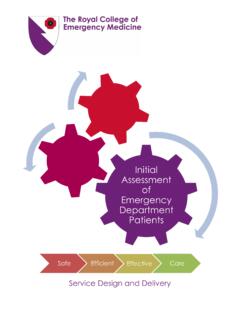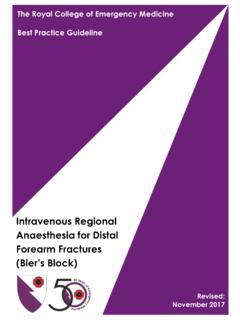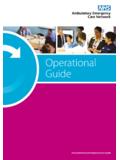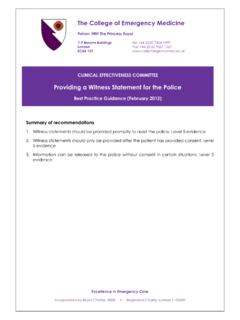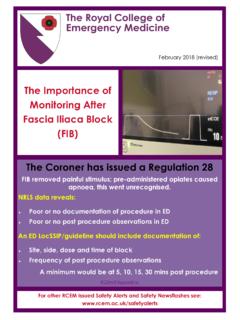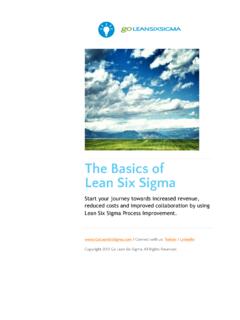Transcription of The Royal College of Emergency Medicine Best Practice ...
1 The Royal College of Emergency Medicine Best Practice Guideline Emergency Department Care July 2017. Summary of recommendations 1. Emergency Departments should strive to consistently provide all 50 care standards listed. 2. These standards should be regularly audited. Scope This guideline has been developed to help medical and nursing staff within Emergency Departments (ED) to provide better care for their patients. As a 50-point checklist, it covers the following themes: The patient environment The ED team Education about care Patient pathway through the ED. Continuing care Care of the elderly patient Care of children Care of patients with complex problems Measuring care and leadership Reason for development The culture of focusing on national targets and financial balance whilst neglecting acceptable standards of care was exposed in the Report of the Mid Staffordshire NHS Foundation Trust Public Inquiry1 (2013), chaired by Robert Francis QC.
2 The Royal College of Emergency Medicine (RCEM) recognises such occurrences are not isolated to one organisation or to one department2. The first recommendation of the Francis report is that all staff should contribute to a safe, committed, compassionate and caring service . The National Advisory Group on the Safety of Patients in England 20133 issued as its first guiding principle: place the quality (and safety) of patient care above all other aims for the NHS . Introduction EDs should aim to provide a safe, committed, compassionate and caring service. This guideline provides a checklist of care initiatives directed at improving patient experience.
3 Standards within are graded as either Fundamental' or Developmental'. Fundamental standards are those which every ED should routinely achieve. Developmental standards are those which departments should be working towards. EDs are encouraged to regularly analyse their Practice using this document. Achieving these standards requires commitment and support. Where a standard cannot be met, this should be escalated to people who can take appropriate action. Understanding the different types of standards Fundamental: need to be applied by all those who work and serve in the healthcare system. Behaviour at all levels and service provision need to be in accordance with at least these fundamental standards.
4 No provider should provide any service that does not comply with these fundamental standards, in relation to which there should be zero tolerance of breaches. Developmental: set requirements over and above the fundamental standards. The patient environment Item Standard Points to consider 1 Are all areas of the ED clean Including the waiting room, reception front entrance and well lit? and its surroundings? 2 Do all toilet facilities in the ED A minimum of twice daily cleaning is advised. clearly display a completed daily cleaning log? 3 Is the physical condition of the Broken or stained ceiling tiles, for example, may give a ED in good order?
5 Poor impression to patients lying on trolleys: if they care for the building like this, how will they care for me? . 4 Do clinical areas enable Can sensitive questions be overheard by other patients patients to retain dignity and and staff? This includes clinical discussion and handover. privacy, including facility to register with privacy? 5 Are waiting areas furnished with: Reading material A number of EDs have a charity book stall. A television A news channel on silent with line feed perhaps? WiFi access Is this made clear to all appropriate age groups including teenagers? Information regarding What can the patient expect: triage, nurse practitioner process or doctor assessment, care, the four hour target etc.
6 See RCEM Best Practice Guideline Giving Information to Patients in the Emergency Department. An updated waiting time 6 Are relatives and carer catered for? Is there sufficient Are patients told that they can use their phones? cubicle seating for patients' relatives and carers? Can patient and Is there a bank of phone chargers available for patient relatives communicate? use? Are bereaved relatives Are bereaved relatives routinely offered a follow up cared for sensitively? appointment with a senior ED physician? 7 Is there a message for : You are in the Emergency Department at recumbent patients on the Standard Hospital.
7 Ceiling tiles in the Resus room? Item Standard Points to consider 8 Is there a dedicated psychiatric assessment room that conforms to PLAN4. standards? 9 In the case of a dying or Consider hanging laminated butterflies, indicating the recently deceased patient, is need for staff to keep noise level and language the relevant clinical area: appropriate. Quiet? Private? Some rooms for bereaved relatives are designed with Sensitively designed? an adjacent room for the deceased. Readily identifiable as such to approaching staff? 10 Is the signage and information The ED can be disorientating. Has it been made easy to for the patients sufficient, to locate and understand the pathway' through the ED.
8 Enable easy navigation to, department? through and from the ED? 11 Is patient feedback sought Consider: and acted upon? A monthly care newsletter Are patients' comments Friends and family surveys (positive and negative) shared Gathering and disseminating feedback from with staff? care rounds5. Many department have Lay Representatives/Patient Voice Representatives at departmental meetings. Is there a nominated ED (senior medical) patient champion? The ED team Item Standard Points to consider 12 Do all staff feel valued? Are there frequent shared examples of positive Does the department meet feedback, either at handover or in writing (or both).
9 The RCN staffing ratios/ Consider care awards in recognition of achievement. requirements, including those Are staff thanked for their efforts by the lead clinician or for children's nurses? senior nurse on completion of post? Is there regular effective feedback to staff? Is there support for those involved in stressful situations? See RCEM Guidance & Resources webpage. Are systems in place to prevent, identify, support and rehabilitate staff burn out? 13 Is there a joint regular Effective team working requires collaboration between scheduled combined medical medical and nursing teams. Joint handovers facilitate and nursing handover?
10 This. 14 Are senior doctors Be approachable and available for the Juniors . approachable and available? See RCEM Non-technical Skills - Top 10 Tips. Are the processes for contacting and involving senior staff clear? 15 Are staff routinely able to take Tired staff are less likely to come across as caring and breaks? they are more likely to make clinical errors. Item Standard Points to consider 16 Is there an effective process to Poor IT support can harm patients and demoralise report and respond to clinical staff. problems with IT, estates and Staff and patients should be able to identify and report equipment?
